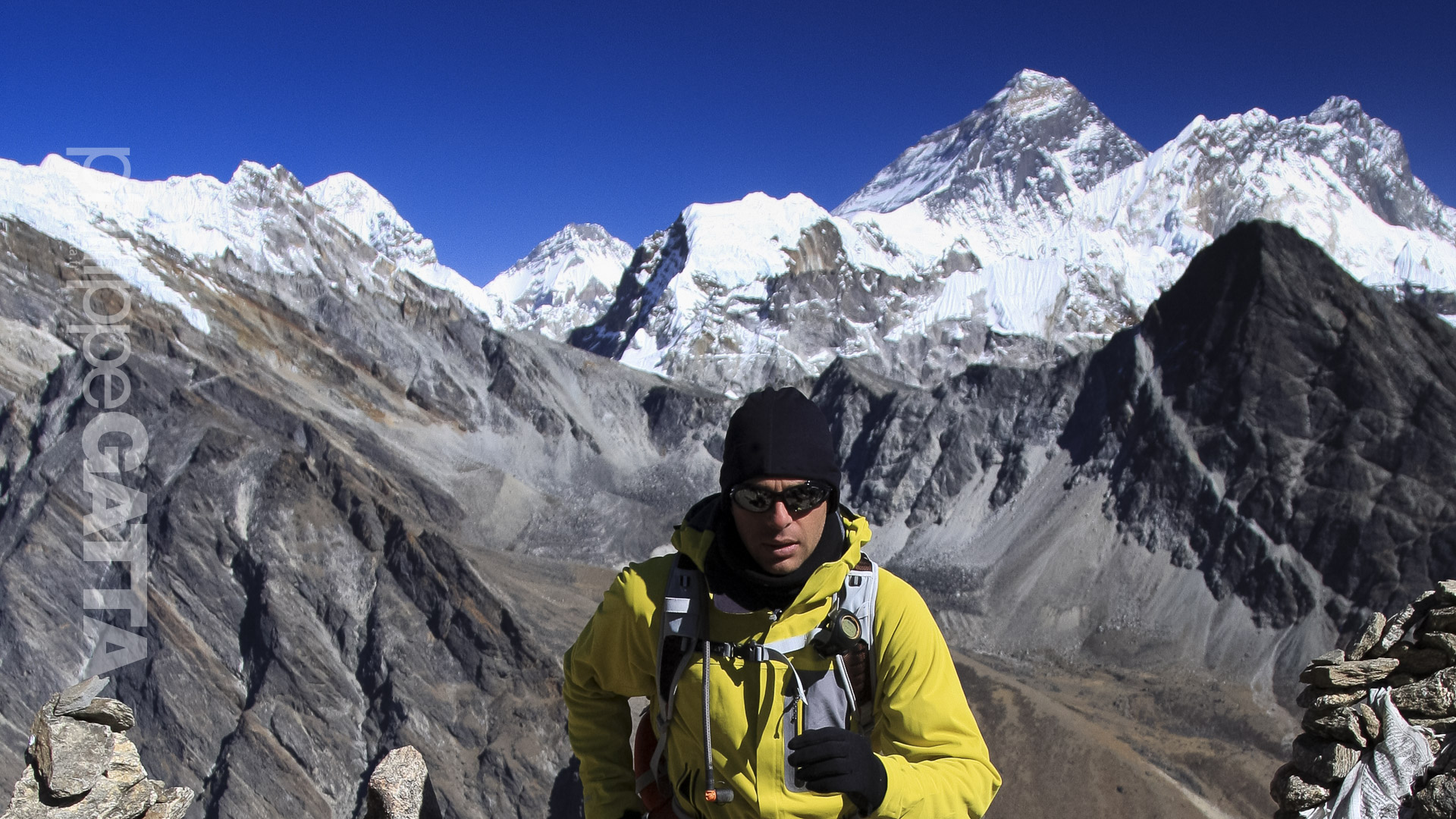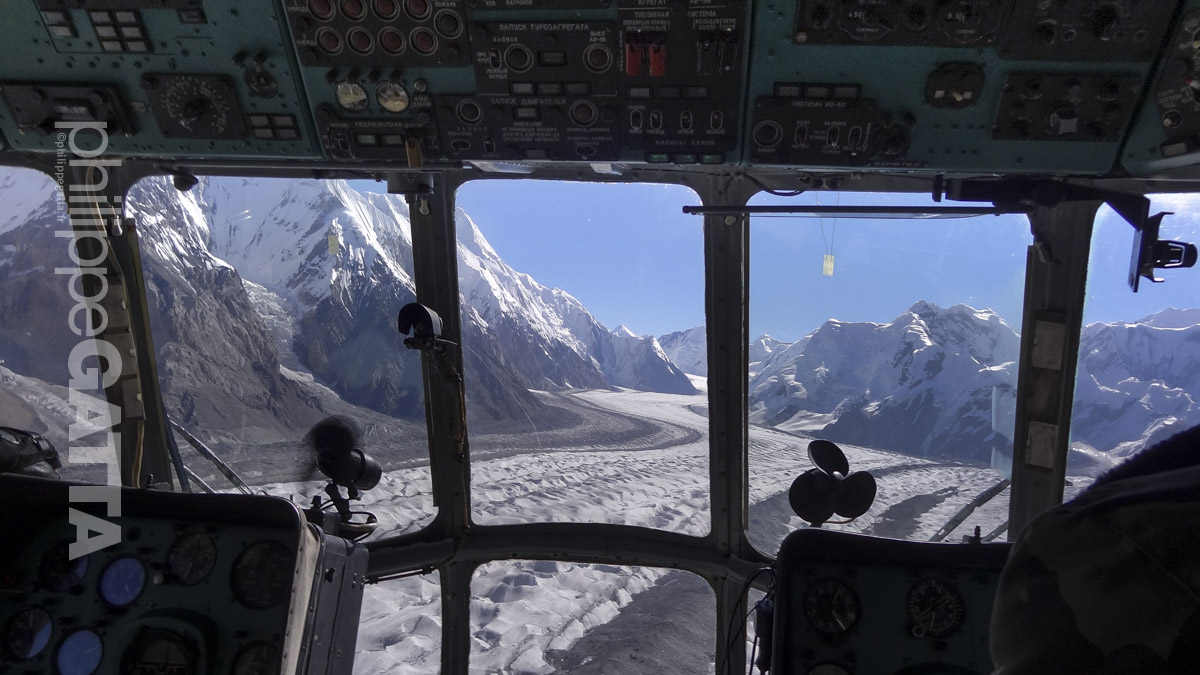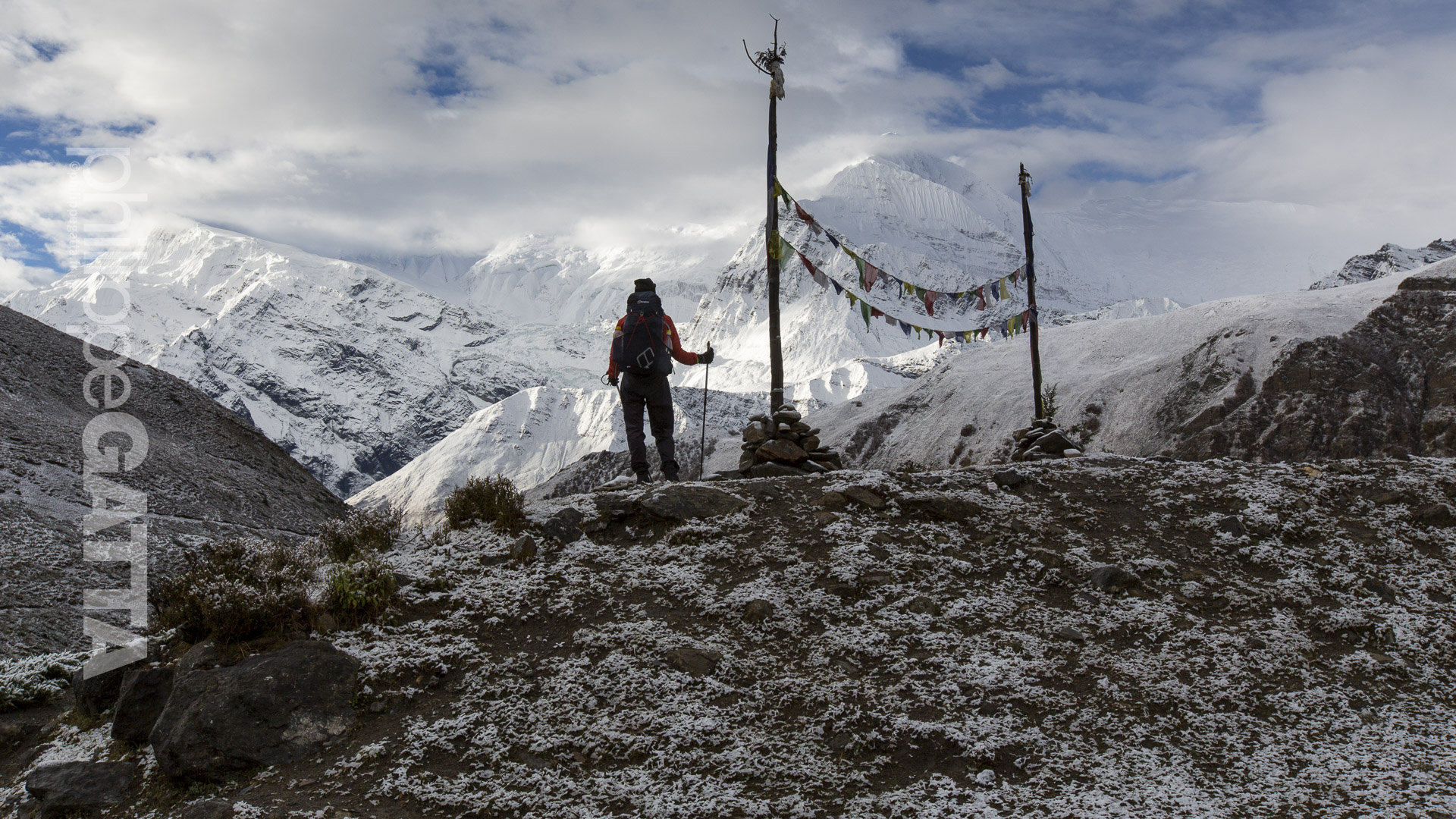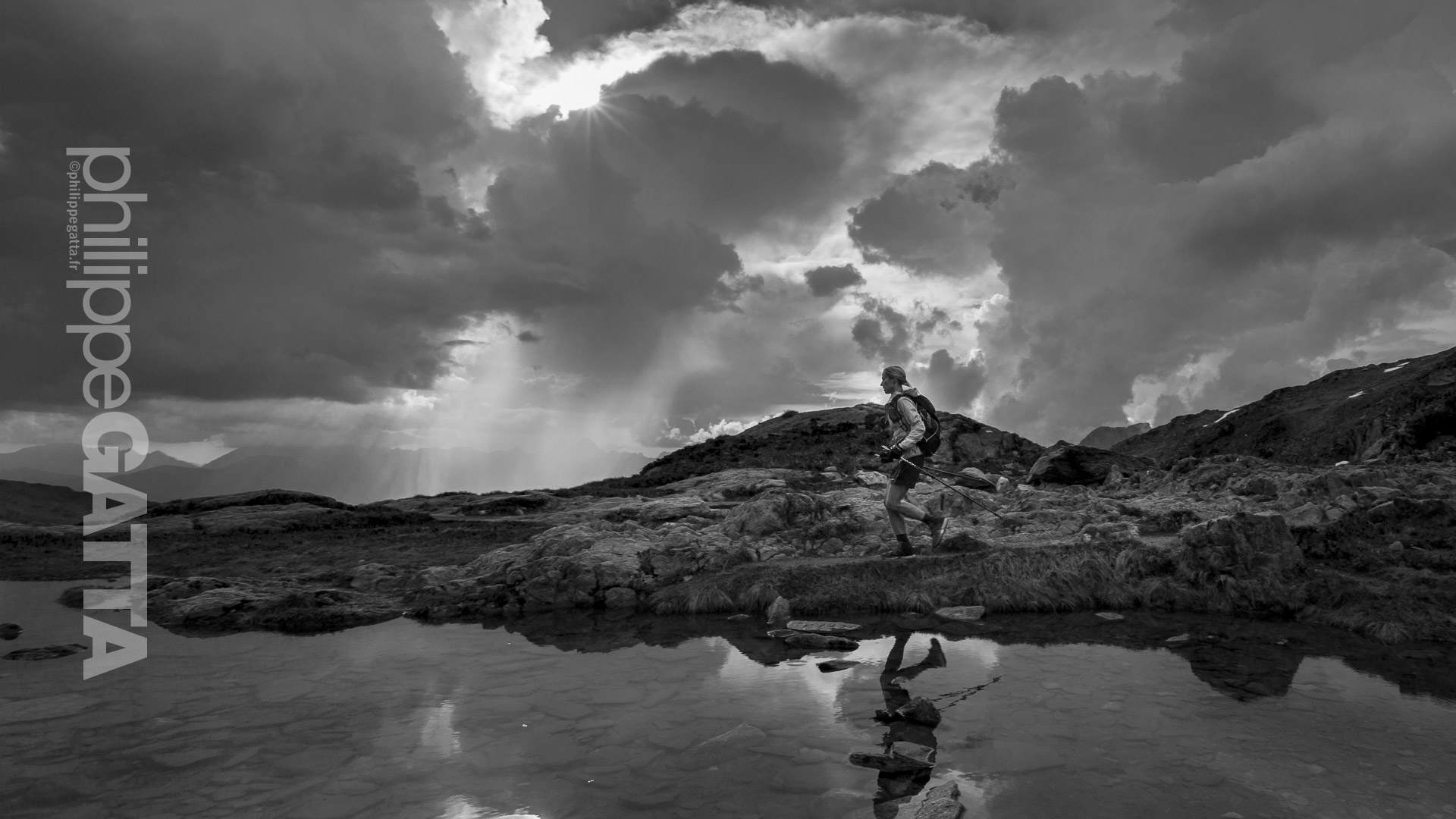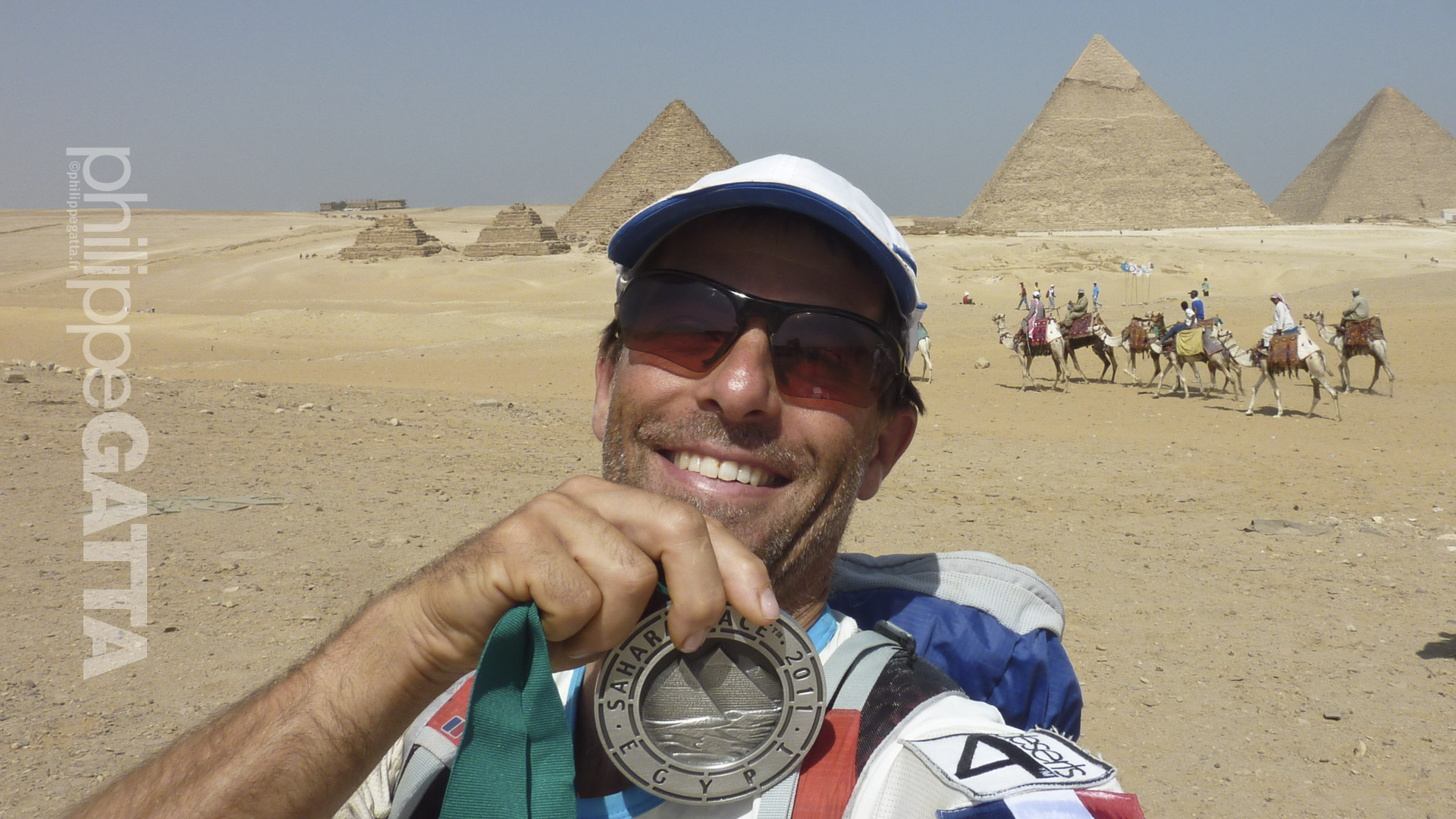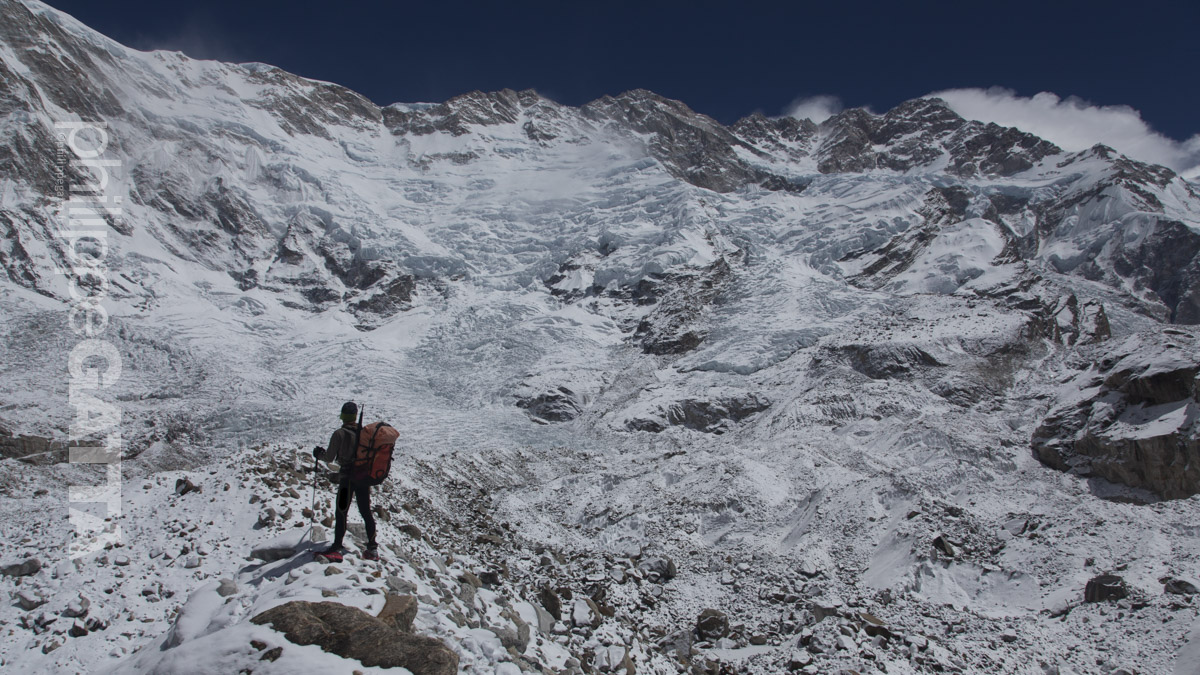MAKALU EXPEDITION (8,463 M)
HIMALAYA, NEPAL
Makalu is a mountain of the Himalaya range, in the Makalu Barun region. It is located 19 km Southeast of Mount Everest, on the border between Nepal and China. With an elevation of 8,463 m, Makalu is the fifth highest mountain in the World. Also, it is one of the 14 mountains on Earth that are more than 8,000 meters (26,247 ft) high.
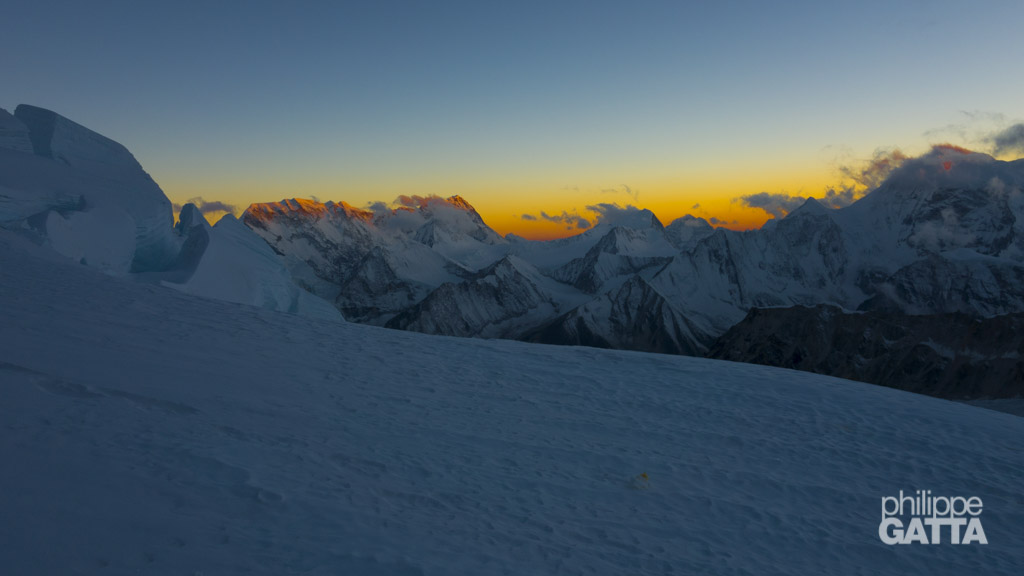
The Makalu was first climbed by a French team on May 15, 1955. Lionel Terray and Jean Couzy were the first to reach the top, while Franco, Magnone, Bouvier, Coupe, Leroux, Vialatte and Sardar Gyaltsen Norbu summitted the following two days.
There are several others notable French ascents; Yannick Seigneur and Bernard Mellet climbed the West Pillar in 1971. In 1988 Marc Batard climbed West Buttress in 24h. One year later, Pierre Beghin soloed the Yugoslav route in the South Face. Then sadly, in January 2006, Jean-Christophe Lafaille disappeared while trying to do the first winter ascent.
As of 2009, 323 climbers reached the top of Makalu among which 20 were French.
Sources: 8000ers.com and Himalayan Database from Elizabeth Hawley archives (himalayandatabase.com).
The Makalu Expedition
Philippe and Pasang Gombu already climbed Everest together. This time they teamed up again to climb Makalu. They left Katmandu and trekked to Makalu base camp. It took them 37 days to reach the top before coming back to Katmandu. Overall, the entire expedition lasted 56 days.
Philippe and Gombu ascended the French route. The starting point is at 5,700 m on the West of Makalu. From there, they climbed Makalu La, a pass at 7,400 m, before heading South to the French Couloir at the bottom of the North face. The ascent concludes on the Northeast ridge.
The base camp (BC), also called Hillary base camp, is located at 4,850 on the Barun glacier. In fact, this BC is used only during the trekking. During the expedition, the climbers stay at the advanced base camp (ABC) at 5,700 m.
The French Route
From the ABC, the route follows a moraine up to crampons point at 5,950 m. Then it goes on the gentle slopes of the glacier to the bottom of a first headwall at 6,250 m where it is possible to set a low camp 1. Climb the headwall to a plateau at 6,370 m where it is also possible to set the camp 1. Pass a small serac to the location of the high camp 1 at 6,450 m.
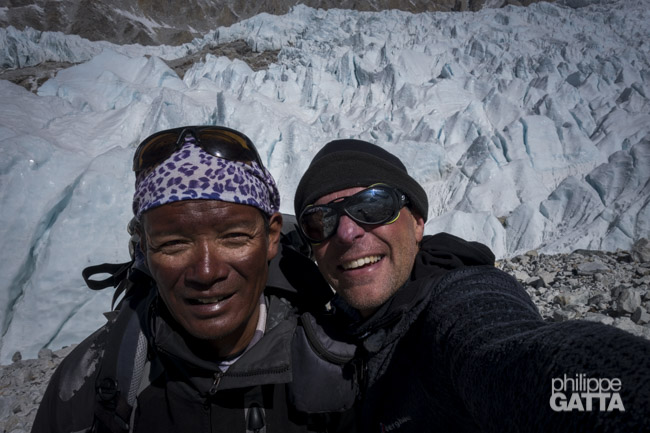
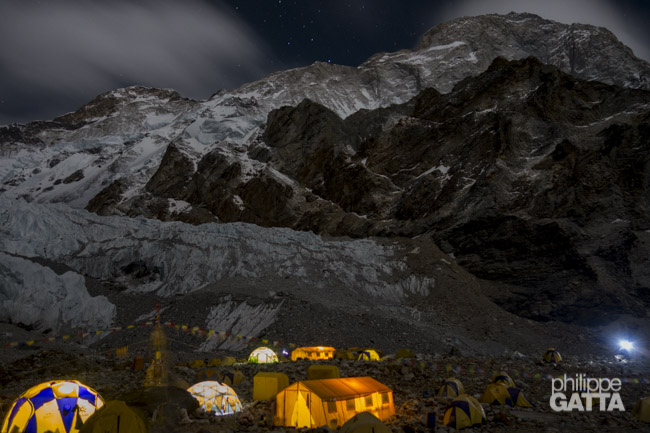
Camp 1 - Camp 2
From the camp 1, climb a short steep slope, cross under a serac and climb another slope to a plateau at 6,650 m. There is a good spot for a camp 2 there, wide enough for a large number of tents.
Camp 2 - Camp 3
From camp 2, you’ll proceed to climb the gentle snow slopes above, moving South to the base of the two rock bands that originate from Makalu La. The first rock band’s base is situated at 7,000 m, where you’ll climb the steep rocks for 150 m, moving up to the middle snow slope for around 200 m at 40°, situated between the two rock bands. Next, you’ll climb the second rock band, which is less steep than the first but higher. You’ll exit on the right of the actual Makalu La and continue on the snow slope until you reach a large plateau, where camp 3 can be set up at around 7,470 m. This plateau is vast and flat, but very exposed to Westerly winds.
Camp 3 - Camp 4
Afterwards, from camp 3, you’ll continue your journey on the plateau towards the Southwest, climb a small wall of mixed terrain, and continue to the rocks at 7,570 m to set up camp 4. The distance between camps 3 and 4 is about 1km and +100 m, so some climbers may skip camp 4 and start their summit bid from camp 3.
Camp 3 - Camp 4
Eventually, from camp 4, climb almost straight on the glacier up to 7,770 m. Cross the seracs to reach the other side of the glacier. Next, climb on the glacier almost straight again up to 8,200 m, then traverse to reach the bottom of the French Couloir. Climb the left side of the French Couloir, which mainly involves a rock and mixed climb with four short (2m) but harder sections. The end of the Couloir is less steep and becomes more snowy. Reach the snow ridge at 8,400 m and follow it, which is relatively large and easy until the base of the false summit. Climb the false summit on the right, which is short but steep and exposed. Traverse from the false to the true summit, avoiding the cornice. Again the climb is short but exposed. Finally, reach the tiny summit at 8,463 m.
Trekking to Makalu Base Camp
The trekking to the base camp of Makalu crosses the Makalu Barun National Park. Actually, this region is more remote and wilder than the famous regions of Khumbu, Annapurnas or Manaslu. In many ways, it is very similar to the Kangchenjunga region.
April 4: Katmandu - Num (1,510 m)
We flew from Katmandu to Tumlingtar and then took a Jeep to the village of Num at 1,510 m (3h30) where we slept in a rudimentary lodge.
April 5: Num - Seduwa (1,550 m)
It is at Num that we started our trekking. From there, we went down to the river at 800 m and then walked all the way up to Seduwa in the heat and humidity.
Stage: 5.5 km, +820m/-775m, 2h45
April 6: Seduwa - Tashigaon (2,110 m)
The second day of trekking to Tashigaon was also cloudy, very hot and humid. Tashigaon is the last village of the valley and is probably the nicest one as well. There were several lodges but all were far from being as comfortable as the ones in the Khumbu or Manaslu regions.
Stage: 8.5 km, +690m/-150m, 2h35.
April 7: Tashigaon - Khongma (3,560 m)
Once again the scenery of this stage was very similar from what we saw in the Kangchenjunga with the same type of trees, moss and Rhododendrons. The trail above Tashigaon was steep and we quickly reached the snow as we gained altitude. We spent most of the time on a ridge but unfortunately surrounded by clouds.
There was only one rudimentary lodge in Khongma.
Stage: 6 km, +1435m/-70m, 3h40.
April 8: Khongma - Dobate (3,850 m)
We were looking forward to this stage which crosses three passes over 4,000 m, normally offering great views of Makalu and surrounding mountains. Unfortunately it was once again very cloudy and we crossed the Ghungru La (4,055 m), the Shipton La (4,220 m) and Keke La (4,152 m) all in the snow. Then we descended after the last pass and reached the only lodge of Dobate which was not even on the map. Dobate was again a very basic lodge.
Stage: 8 km, +840m/-615m, 3h45.
April 9: Dobate - Yangle Kharka (3,640 m)
This time, we started the day under a clear sky and could see the high mountains for the first time since the beginning of the trek. Below Dobate the trail continue to descend in a steep forest of Rhododendrons. Then it goes down to 3,250 m and then goes back up along the nice Barun Nadi (river) up to Yangle Kharka. Yangle Kharka is really a nice place (a Kharka is a grazing pastures for Yaks). There are a few lodges along the river and surrounded by mountains.
Stage: 9.5 km, +400m/-630m, 3h10
April 10: Yangle Kharka - Tumaka (4,015 m)
It was a short day to Tumaka, the last open lodge before the base camp. In fact it was more four basic walls and a roof than a lodge but the place is very nice and surrounded by nice cliffs and icefalls. Like all the lodges of the valley, Tumaka did not not have any stove, so to warm up and cook they burned tons of wood and we already could see the deforestation around…
Stage: 5.5 km, +345m/-10m, 1h30.
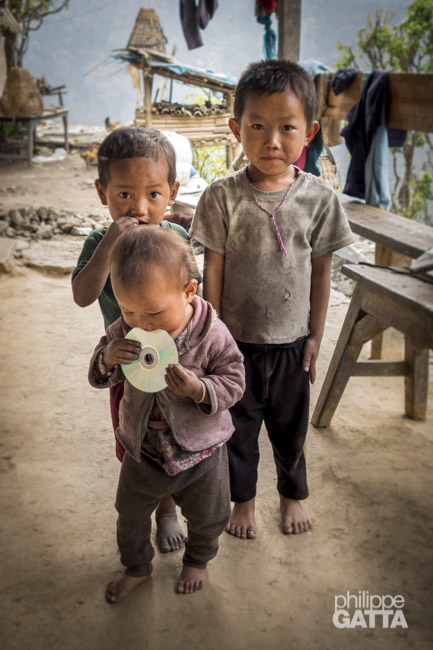
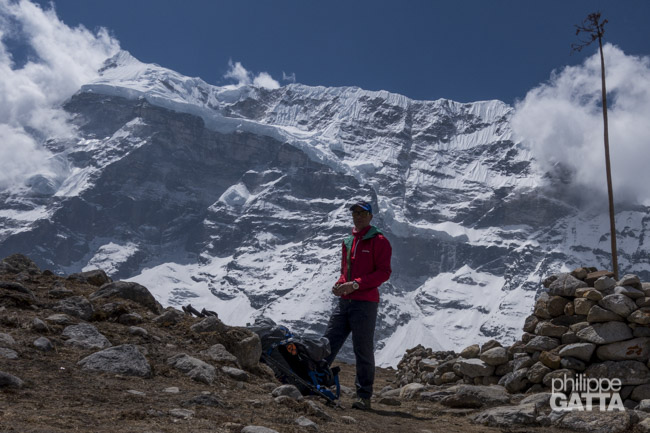
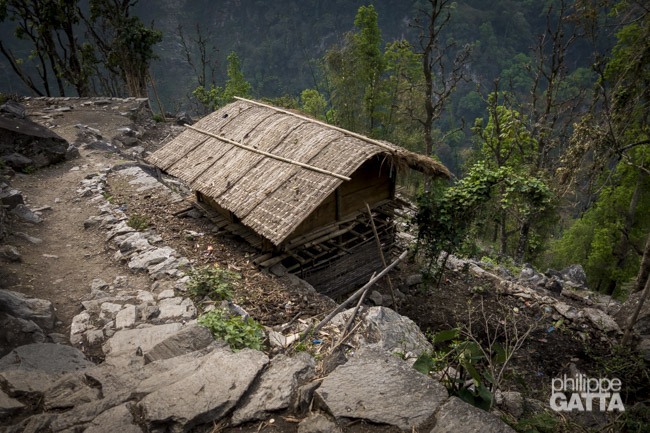
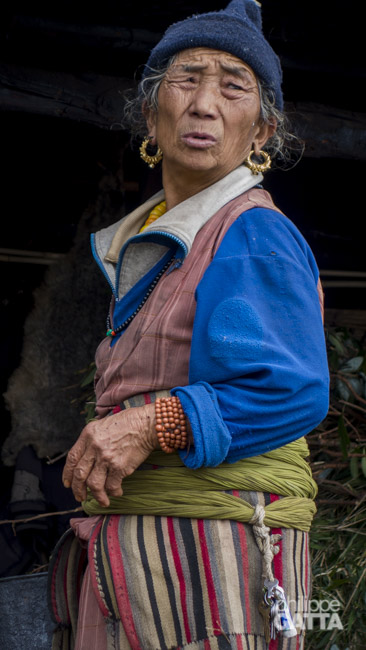
April 11: Tumaka - Hillary base camp (4,850 m)
We leave the last trees just above Tumaka and progressively enter into a mineral world. The peaks around us were higher, all above 6,000 meters of altitude. Most of them were steep, technical and their faces were often higher than 2,000 m high. Then we reached the Barun glacier at 4,600 m but the trail remained very good up to the Hillary base camp. This camp is located on flat area and offers a great view over the South face of Makalu.
Stage: 11 km, +915m/-140m, 4h.
April 12 and 13: acclimatization around Hillary base camp (4,850 m)
We spent two days to rest and walk around the Hillary base camp. In fact this place is too far away from Makalu to be used as real base camp. So climbers usually spend a few days there to acclimatize before going to the advanced base camp (ABC) where they stay until the end of the expedition.
Hike: 4 km, +300m/-300m, 1h40.
April 14: Hillary base camp - Advanced Base Camp (5,720 m)
We left the Hillary base camp early in the morning. The trail was very good up to 5,000 m, then it went in the middle of the Barun moraine. Fortunately we could enjoy the view of the South faces of Lhotse and Everest in front of us. Half way through ABC the trail goes to the right, very close to the bottom of rock faces coming from the West pillar. Finally we reached the advanced base camp (ABC) at 5,720 m, our home for the following weeks.
Stage: 9 km, +1000m/-155m, 5h.
Baruntse to Ama Dablam seen from Makalu Camp 2 (© P. Gatta)
The 37 days of ascent
April 15: rest day at Advanced Base Camp (5,720 m)
At 5,720 m, this camp is very high, probably one of the highest of all 14 8000m peaks. Going from BC to ABC and climbing 1,000 m in one day is not ideal. So we spent the day resting and organizing our tent for the next 35+ days.
April 16: ABC - Crampons point (5,950 m) - ABC
We made our first small acclimatization hike above ABC. Basically we followed the moraine up to the beginning of the glacier that is called Crampons point (5,950 m). Here, we put up a tent to leave boots, crampons, harness that we used from that point on. Then we went back down to the ABC.
Hike: +300m/-300m, 2h. Oxygen saturation: 83%.
April 17: rest day at ABC (5,720 m)
Rest day at ABC..
April 18: ABC - Camp 1 (6,420 m)
Feeling good, we left the ABC for our first rotation with a double objective: carrying gear to the higher camps and continuing our acclimatization by going higher up. The route is pretty easy and straight forward. It was a bit late when we started so it was extremely hot when we reached the headwall at 6,250 m. About an hour and half later, we reached the location of the camp 1 at 6,420 m. The clouds came in, along with a cold wind as we put up our tent.
Climb: +740m/-25m, 3h45.
April 19: C1 - C2 (6,650 m) - C1
As the C2 was just 230m higher, we thought that was not worth moving the tent down and our gear to gain just 230m. As we still wanted to see the route above, we went up to C2 and came back to the C1 the same day.
Climb: +230m/-230m, 1h05.
May 10: ABC – Crampons point (5,950 m) – ABC
The weather forecast improved a bit, predicting a wind drop in the following days. So I decided to exercise again and made another round trip to Crampons point.
Hike: +300m/-300m, 1h10. Oxygen saturation: 86%.
May 11-12: rest days at ABC
I felt better and could stop taking antibiotic. A good weather window was confirmed for the 16th. We decided to go up the following day, SO we climbed straight to C2, spent 2 days there, then move to C3 and C4. After much hesitation we decided to make a C4 because there are 3km and +1,000m from C3 to the summit which is quite a lot.
May 13: ABC - C2 (6,650 m)
The weather window got confirmed for the 16th but it was still quite unstable and windy. As there was no better window forecasted for the coming two weeks, we left for the summit anyway that we hoped to reach 3 days later. We climbed to C2 for the 4th time. All our gear was already in C2 and C3 but we brought more food in case we have to change the plan and have to wait more.
May 14: rest at C2
As planned, we spent this day in C2, resting before the tough climb to C3.
Climb: +950m/-45m, 3h50.
May 15: C2 - C3 (7,470 m)
Once again we left the C2 early, knowing that the day would be long. It was windy and very cold. The route was steep, especially the first rock band. In fact this climb is very demanding whether we use the fixed ropes or not. The weather got worse as we were climbing the second rock band and we reached the C3 in the blizzard. We put the tent up, ate quickly and went in the sleeping bag. In the meantime, the weather forecast got worse and forced us to postpone the summit push by one day.
Climb: +950m/-0m, 7h10.
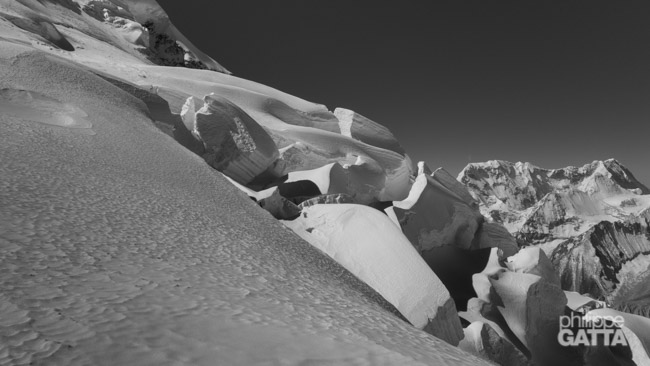

May 16: stuck in C3 at 7470 m
The conditions worsen and we had 70km/h of wind all night and 5 tents were blown away. We wore our down suit inside the sleeping bag and our gear was in the packs in case our tent would have been destroyed. Weather forecast predicted less wind the following days so we spent that day in C3.
May 17: C3 - C4 (7,570 m)
The wind dropped and we could move up to C4. The climb was even shorter than what we expected, just 1h10. The C4 was in a nice place and better sheltered than the C3.
Climb: +230m/-130m, 1h10.
On the way to Camp 4. Everest South Col in the background
May 17 evening - 18: C4 - Makalu summit (8,463 m) - C3
We spent the afternoon resting and planning the climb with the rest of the team. There was no fixed rope on the upper part of the mountain, just a small 6mm rope in the French Couloir and nothing above. We took 60m of rope.
At 9pm, we left the C4. We crossed the glacier with the rest of the team and took the lead above. Then we reached the summit ridge above the French Couloir just at sunrise.
Above the French Couloir the route was easier until the false summit. Soon, we climbed the false summit and the final ridge to the true summit in solo, using old fixed ropes now and then.
We reached the summit of Makalu just before 6am, after 9 hours of climb. We enjoyed the view for 15 minutes and started the descent.
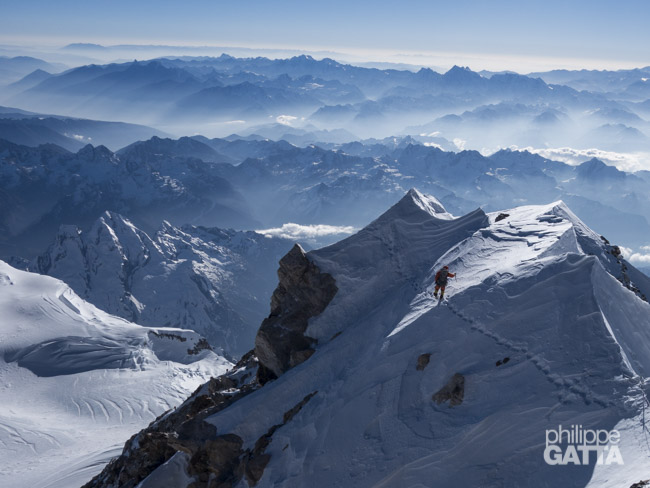
We met the rest of the team on the ridge above the French Couloir. They all reached the top a bit later.
Three hours later, we were back at C4, we packed everything and continued our descent to C3. Someone ate the food that we left in the tent so we ate some snacks, a couple of bars and slept.
Climb: +1130m/-1230m, 12h10.
May 19: C3 - ABC
We left the camp 3 early in the morning with all our gear, tent, clothes and rubbish.
Later, we made a quick stop in camp 2 to gather the food we left there and continued our descent to ABC. It was amazing to see how the mountain had changed since we started our ascent a week before. Particurlaly, most of the snow had melted below 6,200 m.
Climb: +25m/-1775m, 3h15.

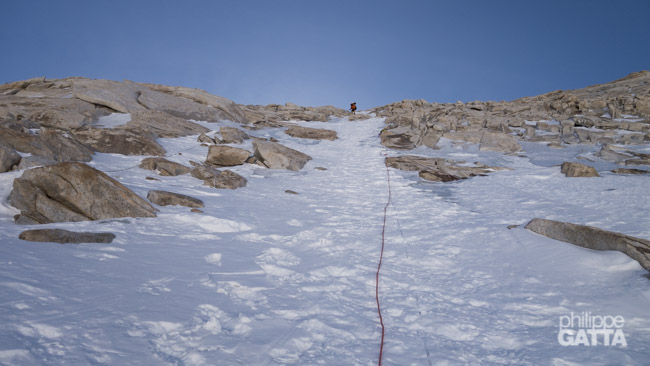
May 21: ABC - Hillary BC
We trekked from ABC to the Hillary BC. The snow had melted, all the slopes above the Barun glacier were dry, causing many rock falls.
Stage: 9 km, +155m/-1000m, 3h.
May 22: return to Katmandu
Gombu and Philippe safely returned to Katmandu.
Wider magazine posted a short story about Philippe and Mike Horn ascent of Makalu (8463m)

